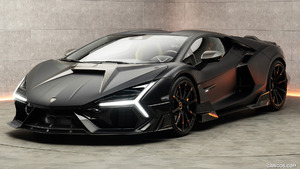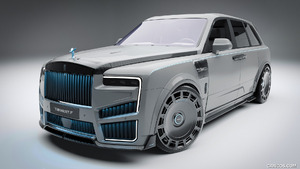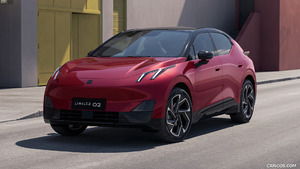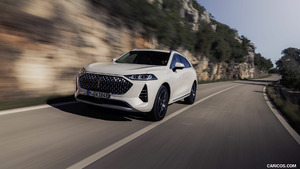Toyota FT-1
Toyota virtually blew the doors off the North American International Auto Show with the reveal of the stunning FT-1 sports car concept. First devised by Calty Design Research in the Sony PlayStation Gran Turismo game environment, FT-1 leapt from the screen to the stage in a race-inspired press conference at COBO Hall.
The name says it all. FT-1 stands for “Future Toyota,” and the number “1” represents the ultimate. According to its designers at Calty Design Research, the FT-1 Concept is the ultimate expression of a Toyota coupe design, building upon Toyota’s rich sports coupe heritage dating back to the 2000GT, Celica, Supra, MR2 and most recently Scion FR-S. In addition, the concept draws inspiration from Calty’s more recent sports car concept work such as FT-HS (2007) and the Lexus LF-LC (2012).
The project started nearly two years ago and represents a labor of love by a passionate, dedicated and gifted Calty design team. “The FT-1 is a dream-project for a designer and car enthusiast like myself,” said Alex Shen, Calty’s Studio Chief Designer. “Our team was heavily influenced by Toyota’s sports car past, especially Celica and Supra, and we sought to capture some of that history. It is an aggressive, track-focused sports car concept with a presence that has been amplified for shock and awe.”
The FT-1’s audacious design represents the pinnacle of Calty’s 40th year of operation. Guided by the Toyota design ethos of Vibrant Clarity, a unique fusion of both emotional and rational factors that delivers a more exciting and dramatic design expression with unique Toyota identity, the concept is a spiritual pace car for Toyota Global Design. The goal of this ideological shift is to develop future generations of products that better connect emotionally with Toyota’s global consumer base.
Traditionally, Toyota’s design decisions have been driven by consensus among a large group of stakeholders. Under Akio Toyoda’s stated directive to invigorate Toyota products with energy, passion and “Waku-Doki” (translation: a palpable heart-pounding sense of excitement), the approval process has been streamlined. This new approach aims to produce cars that connect more deeply with customers, generating a more satisfying ownership experience that complements Toyota’s legendary reputation for quality, dependability and reliability.
“Function-sculpting” design language yields curved, muscular, expressive body forms seemingly shaped by the wind. Inlets, ducting, and vents are features of the exterior design that help reinforce its track–ready nature with elements of purposeful airflow management. At higher speeds a retractable rear wing deploys and tilts forward to create additional downforce. The body’s athleticism is expressed with taut surfaces and dramatic fender forms that seduce the eyes when covered in an unapologetically red hue.
The front engine rear-wheel drive configuration locates the cockpit far rearward within the wheelbase to improve weight distribution. This design element also helps create the classic sportscar proportions one would expect from a vehicle poised to dominate even the most challenging road course. The cockpit’s wraparound windshield and side glass openings are a distinct nod to the design of the legendary Toyota 2000GT.
The interior is a focused, highly functional “place of business” that locates the driver at the controls behind an F1 inspired steering-wheel. The intimate, low slung cockpit has its A-pillars set far back to help optimize cornering vision and sensation of the cabin’s intimacy. A delta-shaped display zone surrounds and integrates the driver to provide an exhilarating sense of being connected to the vehicle. The cockpit’s sense of minimalism adds to the purposefulness of the driver-focused environment with an emphasis on light weight components such as the composite seat covered with just the right amount of padding in only the areas that come into contact with the driver. A color heads-up display keeps the driver’s attention on the road ahead, with vital information projected just above the steering wheel within the driver’s line of sight.
While technical specifications do not accompany the concept, one can assume that the FT-1 represents an ideally balanced front-engine, rear wheel-drive layout that is powered by a high-technology, high performance internal combustion engine. Beneath a transparent glass hood, an ambiguous engine cover hides a powerplant left to the imagination of the onlooker.
In preparation for pitching the concept to Toyota management, Calty worked with Polyphony Digital, creators of the popular Gran Turismo driving simulator, to bring FT-1 to life in a virtual world that captured the excitement, passion and performance conveyed by the concept model. Toyota executives were offered the opportunity to take FT-1 for a timed lap around a computer-generated Fuji Speedway. Behind the wheel of the concept, Toyota president Akio Toyoda, an accomplished race car driver, completed the virtual circuit faster than his best real-world lap time at Fuji in his LFA. From that moment, he was convinced and the concept was approved to be built in model-form for the international auto show circuit.
For Toyota, this concept embodies the possibilities of the new and exciting design mission ahead. “Sports cars represent the ultimate driving expression in its purest form. As car enthusiasts ourselves, this is the kind of project we dream about working on,” said Calty Design Research president Kevin Hunter. “Beyond its obvious five-alarm visual impact, FT-1 is symbolic of a new chapter for Toyota Global Design. This provocative concept truly captures the passion, excitement, and energy of the Toyota we are evolving into and embodies elements of the emotion and performance that Toyota will imprint upon future production designs.”
Graphite
Proof that its beauty lies on the inside and out, Toyota revealed today a second interior styling and exterior color for an upscale interpretation of its sensational FT-1 sports car concept. Developed by Calty Design Research in Newport Beach, California, the concept vehicle’s graphite exterior paint and light, saddle-colored leather went on display for the first time at the Gordon McCall’s Motorworks Revival gala held on California’s Monterey Peninsula.
The original FT-1 concept ignited sports car enthusiasts and the automotive world with its January debut at the North American International Auto Show. Labeled the spiritual pace car for the new direction of Toyota Global Design, the muscular, curved exterior builds on Toyota’s rich sports coupe heritage dating back to the 2000GT, Celica, Supra, MR2 and most recently Scion FR-S. That first vehicle stunned in a bold red, while this second FT-1 impresses with sophisticated graphite. Both share the deeply sculpted intakes and outlets that support its track-ready nature and the dramatic lines seemingly shaped by the wind. It’s a look that gets the heart racing.
The color of the upscale leather changes between the first and second FT-1 vehicles, and the visual difference is striking. The first car was dominated by bold, masculine black that keeps the driver focused on the road, while red painted edges and raw metals provide intriguing accents. In the second, the natural leather on the seat is supple with an all-natural grain, giving it an authentic appeal. The painted edges that are red in the first concept are now subtly blended brown in the second. The intention is to bring in a more sophisticated feel and authenticity through color choice, showcasing the versatility of the FT-1 sports car concept. Enthusiasts who desire a more pure high-performance experience might choose the black-red pairing, while others may desire the premium, athletic feel of the saddle leather.
“From the start of the FT-1 project, we wanted the driver to have a feeling of flow while at the wheel – to be able to focus on the road and nothing else,” said Sellene Lee, the Calty creative designer who proposed both color concepts. “In the color studio we help create the atmosphere of the vehicle, and our aim was to ensure everything supported the driver through efficient choices. The saddle leather maintains that same ‘in the zone’ driving intention, while bringing in a more premium feeling.”
Superhero Inspiration for the Interior
Sellene Lee drew inspiration for the FT-1 interior from the modern, high-tech performance materials used for today’s superhero costumes. A movie poster drew her attention to the modern shift from past heroes’ bright tights and colors to today’s performance fabrics and function. To achieve the FT-1’s advanced-looking, intricately detailed interior, Sellene Lee and the team compared leather thicknesses, grain sizes and textures to find the perfect combination. Raised metal mesh provides ventilation for the seats while lending a more textural, bold effect that beautifully matches with the metal accents. A dimensional embossed pattern on the instrument panel leather brings in a 3-D, technical look.
“From color and trim standpoint in the FT-1, there was a laser-like focus on staying true to function,” said Wendy Lee, studio chief designer at Calty. “This project was very special, as the FT-1 stands apart in its performance-driven, authentic purpose.”
Beyond her superhero performance material concept, Sellene Lee moved away from the typical stitching or piping edge treatment found in many vehicle interiors. The painted red edges on the welded leather and painted brown edges on the second FT-1 were inspired by high-end leather bags she found in an upscale department store. When drivers sit in FT-1, they can feel the difference in materials, textures and color choices that resulted from the team’s work.

















